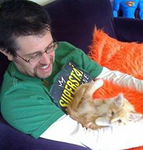Irvin Kershner, Director Of The Empire Strikes Back, Dies At 87
None
Veteran director who also called the shots on RoboCop 2 , Never Say Never Again and Eyes Of Laura Mars
Sadly, SFX has to report that Irvin Kershner, director of many fans' favourite Star Wars movie, The Empire Strikes Back , died today in Los Angeles at the age of 87 after a long illness.
Irvin Kershner was born in Philadelphia in 1923, and initially it looked like he was destined for a life in music (he played viola and violin) although fine arts was another passion. But when he moved to Los Angeles he began to study photography, and eventually he ended up at the University of Southern California School of Cinematic Arts, teaching photography and taking cinema courses. So when he took a job as a stills photographer in Iran, he soon made the move into being a documentary cinematographer, working in Greece and Turkey with the US Information Service.
He then moved back to the States, working initially on TV documentaries, before moving on to directing TV dramas (he helmed the pilot for the legendary soap opera Peyton Place ) and films. He directed his first Hollywood movie, Stakeout On Dope Street , in 1958.
His first SFX -relevant film was Eyes Of Laura Mars (1978) starring Faye Dunnaway as a photographer who begins to see through the eyes of a serial killer. Soon after George Lucas offered him the directing gig on the sequel to Star Wars . Initially, Kershner was reluctant, afraid that the sequel could never be as good as the original, but his agent had other ideas, and the director took up the challenge. Lucas was allegedly keen to use Kershner because, “You know everything a Hollywood director is supposed to know, but you're not Hollywood.” He was also fine about his name not being credited at the start of the movie; back in the ’70s this was considered a heinous crime against Hollywood, but Lucas had put all of Star Wars’s credits at the end of the movie, and he wasn’t changing format with Empire. In Kershner he found an unassuming director who wasn’t going to let his ego get in the way in that regard. The Writers Guild and the Directors Guild of America saw things differently, and fined Lucasfilm over $250,000. When the DGA started attacking Kershner as well for being complicit, Lucas paid the fines and left the Guild for good.
Of his Star Wars experience and his working relationship with George Lucas he told Vanity Fair : “There was really only one disagreement. It was the Carbon Freeze scene when Princess Leia says, ‘I love you.’ Han Solo’s response in the script was, ‘I love you, too.’ I shot the line and it just didn’t seem right for the character of Han Solo. So we worked on the scene on the set. We kept trying different things and couldn’t get the right line. We were into the lunch break and I said to Harrison try it again and just do whatever comes to mind. That is when Harrison said the line, ‘I know.’ After the take, I said to my assistant director, David Tomblin, ‘It’s a wrap.’ David looked at me in disbelief and said something like, ‘Hold on, we just went to overtime. You’re not happy with that, are you?’ And I said, ‘Yes, it’s the perfect Han Solo remark,’ and so we went to lunch. George saw the first cut and said, ‘Wait a minute, wait a minute. That’s not the line in the script.’ I said ‘“I love you, too" was not Han Solo.” Han Solo was a rebel. George felt that the audience would laugh. And I said, that’s wonderful, he is probably going to his death for all they know. We sat in the room and he thought about it. He then asked me, ‘Did you shoot the line in the script?’ I said yes. So we agreed that we would do two preview screenings once the film was cut and set to music with the line in and then with the line out. At the first preview in San Francisco, the house broke up after Han Solo said 'I know'. When the film was over, people came up and said that is the most wonderful line and it worked. So George decided not to have the second screening.
“George was the best producer I ever worked with. He left me alone and only came to England a few times. I told George at one point that I was behind schedule, not that it was anyone’s fault, but because it was so complex. Many of the special effects that were done on set often did not work at all. His answer was, ‘Keep doing what you are doing. Just keep shooting.’ This was the greatest thing for a director to hear from a producer.”
Get sneak previews, exclusive competitions and details of special events each month!
Kershner then courted more controversy when he went on to direct the breakaway Bond film Never Say Never Again with Sean Connery returning to the role. After that he directed yet another sci-fi sequel, RoboCop 2 (which wasn’t a match for the original but has its fair share of fine moments) and also helmed the pilot episode of Spielberg’s aquatic SF series SeaQuest DSV .
Of his cinematic style, Kershner once said, “I like to fill up the frame with the characters’ faces. There’s nothing more interesting than the landscape of the human face.”

Dave is a TV and film journalist who specializes in the science fiction and fantasy genres. He's written books about film posters and post-apocalypses, alongside writing for SFX Magazine for many years.


